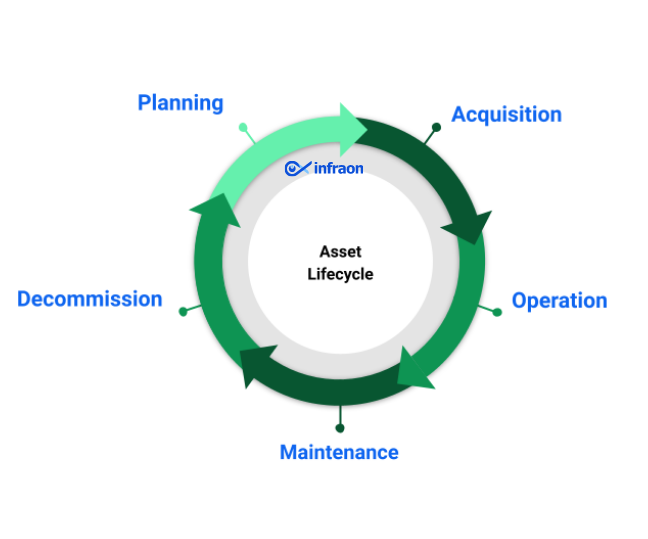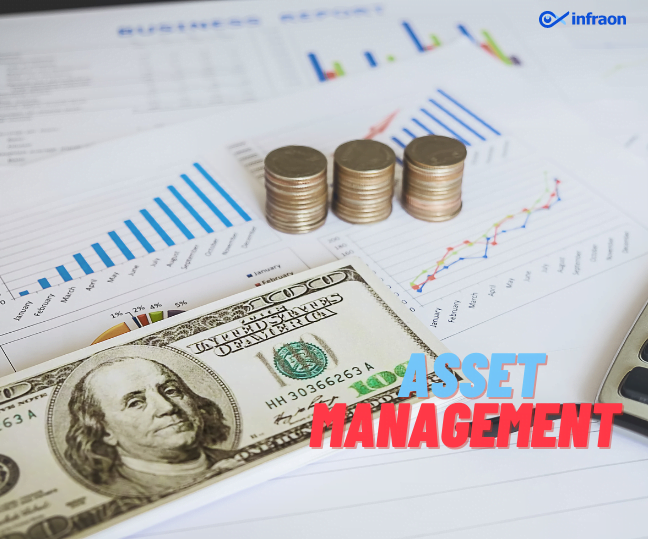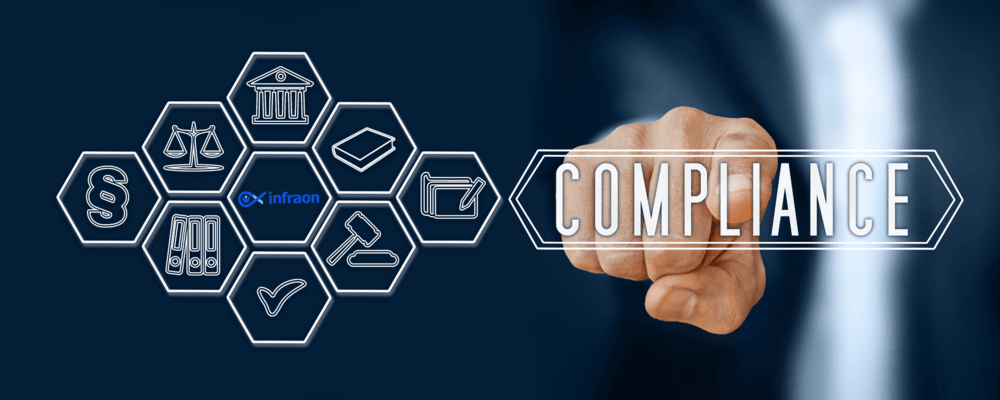Revenue is a term indispensable in corporate talk. As it’s the largest number on the profit and loss statement for the company, revenue is frequently referred to as “the top line.” And business owners and managers are very attentive to this statistic.
Businesses in all asset-intensive industries, particularly the power and utility sectors, are under increasing pressure to deliver better customer service, improve equipment uptime, and advance performance predictability.
Hence, for a company to generate more revenue and perform better, it’s necessary to maximize the accessibility and management of its assets. This paves the way for digital tools to enter and improve asset lifecycle management.
Knowing your assets’ lifecycle helps you better prepare for your assets’ roles in your company, enabling you to save time, effort, and resources.
Businesses can better understand and analyze the lifecycle of each asset owing to tools such as asset management software.
This eventually helps business owners make better purchasing decisions, increase equipment efficiency, and reduce unnecessary spending and maintenance.
What is an asset lifecycle?
Everything from deciding whether or not an asset is needed to dispose of it once it’s no longer useful is referred to as the asset’s lifecycle.
Facilities managers may maximize the life span of their assets and make the most of a finite lifespan by using asset lifecycle management.
Effective asset lifecycle management can increase asset reliability and decrease the likelihood of spontaneous failure. They can also extend asset lifespans and lower the cost of maintaining the asset over its lifetime.
Stages of asset lifecycle
Each asset goes through four stages during its lifecycle.

Asset management lifecycle diagram
- Create/Acquire
- Utilize
- Maintain
- Renew/Dispose
Although these lifecycle stages appear straightforward on the surface, maintaining all of your assets in accordance with and across these stages can be challenging.
Let’s examine each one and its function.
1. Create/Acquire
The first phase is the creation or acquisition of the asset, and these could be combined to produce a hybrid asset that properly fits the company’s needs. It’s also the time when most error occur.
Until the asset is renewed or disposed of, any errors in setup or calculations made at this stage can impact all subsequent stages.
2. Utilize
In the asset lifecycle, many organizations may combine utilization and maintenance; in reality, they are two distinct stages. This is particularly true if urgent work or other maintenance requirements must be completed, keeping the asset out of operation for a while.
Utilization should be the stage your assets remain in the longest. If the opposite is the case, the asset’s productivity decreases, affecting the company’s bottom line.
3. Maintain
The work you’ll do on the asset from the start to the end of its lifecycle is called maintenance. Preventive, proactive, emergency, time-based, and other types of maintenance fall under this category, but they are not the only ones.
It’s important to remember that maintenance and utilization must go hand in hand for the best results.
4. Renew/Dispose
The renewal or disposal of an asset is the final phase of its lifecycle. Throughout their lifetimes, all assets will produce data that will help businesses determine the best course of action. But usually, this information is not gathered in a way that would be most helpful to the executives or managers making these choices.
This information should be available to the company well before the renewal or disposal stages so businesses can use it appropriately.
Despite how straightforward it may sound, it’s rare for businesses to proceed through each stage methodically.
Proactive maintenance and the initial setup are the ones that people tend to overlook. This can result from out-of-date procedures, inadequate data, carelessness about the questioned asset, or just simple forgetfulness.
What is asset lifecycle management?
Asset lifecycle management refers to monitoring every aspect of an asset during each stage of its association with an organization.
To start, it will decide what form the asset will take, how much it will cost, and how long it should last. If the organization doesn’t develop and integrate the asset internally, asset lifecycle management may involve external contractors.
The following actions can be included in asset lifecycle management:
- Defining the asset’s function in the organization
- Including the asset in the budget
- Approving its production or acquisition
- Integrating an asset into the tracking system
- Checking for depreciation
- Installing and looking for software updates
- Starting preventative maintenance and
- Maintaining compliance with regulations

Benefits of asset lifecycle management
Asset lifecycle management may appear to be quite labor-intensive and has become a natural extension of asset tracking, budgeting, and decision-making.
Here are the major ways asset lifecycle management can help companies
1. Extend the asset’s lifespan
You may learn a lot about how an asset works and when maintenance is most beneficial by monitoring its lifecycle. Create an asset lifecycle plan using this data, emphasizing the best maintenance schedules and methods to keep the asset in top working order.
You can extend the asset’s life span by stepping in with preventative maintenance at these crucial times.
78% of organizations that monitor preventive maintenance and track maintenance history claim to have noticed an increase in equipment lifespan.
2. Boost facility efficiency
Enhanced asset efficiency is another advantage of asset lifecycle management. Regular upkeep keeps assets in peak condition and reduces damage from negligent handling.
Increased facility efficiency results in well-maintained equipment, longer asset lifespans, and decreased equipment downtime.
3. Empower the decisions you make
Asset lifecycle management gives data about your facilities that you may otherwise overlook. This information can guide your decisions and create better future strategies.
For instance, you’ll have the financial information to support your thought process and assist you in arriving at the most cost-effective solution when making decisions like repair or replacement.
Here are a few other ways asset lifecycle management helps organizations
- Enhanced planning for preventive maintenance
- Enhanced and more meaningful communication with all the organization’s employees
- Enhanced IT services
- Greater supply chain efficiency
- Better control over budget predictions
- Awareness of part replacement schedules
- Thorough understanding of regulatory compliance
- Minimization of catastrophic downtime
Asset lifecycle management is a common practice in organizations, albeit it’s rarely defined or formal.
By making the process more streamlined, it’s possible to make each part of asset lifecycle management clearer and more efficient, convey it to employees, and make the procedure more familiar to new team members.
Maintaining a practical and effective asset lifecycle management system optimizes personnel needs and boosts investment returns. It increases staff involvement in day-to-day activities and better utilizes data.
How can companies implement asset lifecycle management?
Asset lifecycle management’s fundamental tenet is maximizing an asset’s lifecycle without compromising functionality. Planning and managing these procedures are crucial.
Great asset lifecycle management has four major components. These comprise initial and continuing assessment, data gathering from assets, development of proposed plans, and integration across all assets.
1. Assessing the situation
It’s imperative to focus on the assets under consideration. This is the time to speak with those most familiar with the asset, examine any paper or digital records that have been kept about it, and consult any other primary sources that could provide you with data and information on the asset in question.
If they do not directly affect your asset lifecycle, you should not be focusing on your employees, management, production, or any other aspects at this time. It’s not a good idea to concentrate on other ethical difficulties, such as inadequate training, an understaffed or overworked workforce, or other issues involving people.
Various areas to concentrate on include:
- Asset data
- Operations
- Competitor assets (if this information is available)
- Current and predictive market worth
2. Data gathering to validate or disprove the hypothesis
Big data is currently popular in many industries, and for a good reason. It can validate or disprove your theories about what’s happening and how to fix it with a decent degree of certainty.
Assets are frequently divided through siloing. They rarely all collaborate, and when they do, the more modern or technology assets usually interact. Large equipment, tool sets, production line equipment, and other similar assets are hardly ever connected.
The short answer is that it can be very challenging in some situations to gather, store, and evaluate the data these assets offer.
Obtaining high-quality data can be challenging, but the effort is worth it. Even though many businesses opt not to invest in data collection, it’s the only surefire way to confirm or refute hypotheses about your assets, and data has the solutions.
Data is, therefore, a crucial component of asset lifecycle management.
3. Develop, implement, and test plans
A company may run into serious problems if it doesn’t already have a strategy in place to manage the asset lifecycle. This is especially true if the testing and plans are ad hoc and spontaneous.
It’s a good idea to start with your company’s current policies and practices in these circumstances.
- What is already set up?
- What might be better?
- Do you need to change your policies?
Companies can learn during this process that their policies need to be revised or updated to carry out a strategy or approach. This can require more time than anticipated, but it’s worth it.
4. Integration across all assets
It’s time to implement your plan across all your assets in an orderly, integrated manner; this is where an IT asset discovery tool steps in.
it’s generally preferable to save this stepping stone until last. The effort to implement the plan in the past is crucial to achieving an integrated strategy across all assets.
ROI calculator
The difference between what businesses report on their books and what they have is typically between 3 and 5%. As a result, “ghost assets” are created—these assets are recorded and aren’t there.
Using the asset tracking software from Infraon, you can avoid paying for these assets (with the tax, maintenance, and insurance-related to them).
Here is our ROI calculator to help you estimate how much revenue you can save annually by integrating an asset management solution.
Conclusion
Asset lifecycles impact every aspect of the business, from acquiring a new asset to its disposal. Assets can provide an even better return on investment if they are kept up properly throughout their lifespan.
Additionally, an awareness of asset lifecycles will be a key component of a preventative maintenance strategy if businesses are serious about using an all-encompassing maintenance solution, such as an asset management solution.
And if you are a company looking to simplify asset management and extend the lifecycle of your assets, Infraon may have the solution for you.
FAQ’s
1. What are the four phases of the asset lifecycle?
Each asset goes through four stages during its lifecycle,
- Create/acquire
- Utilize
- Maintain
- Renew/dispose
2. What is a lifecycle asset management plan?
A lifecycle asset management plan is a tactical move a business makes to lengthen the lifecycle of an asset, like production equipment or a company car. An organization can better manage the lifecycle of a piece of equipment by establishing an asset management lifecycle process.
3. What is the equipment lifecycle?
The phases in the equipment’s lifecycle are described as equipment lifecycle. The equipment’s lifecycle typically starts with planning, during which the necessity for that equipment is first established and lasts until it’s disposed of.



















